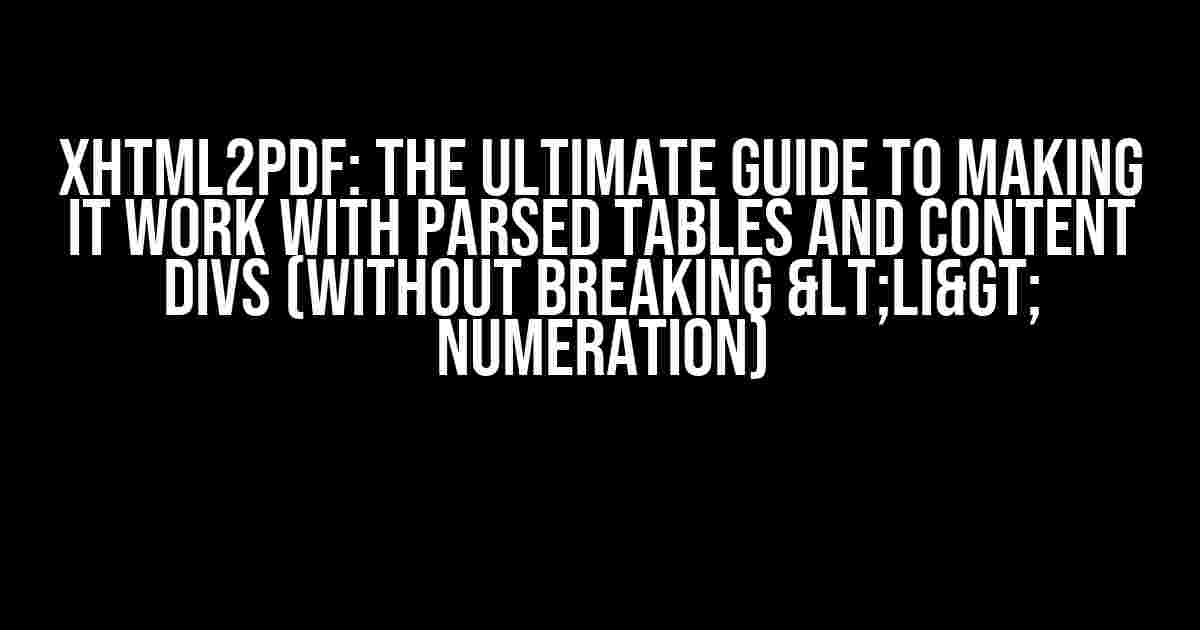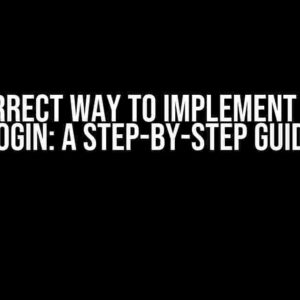Are you tired of struggling with xhtml2pdf when working with parsed tables or content divs? Do you find that your beautiful <li> numeration gets broken and becomes a jumbled mess? Fear not, dear friend, for we’ve got the solution for you! In this comprehensive guide, we’ll take you by the hand and walk you through the steps to make xhtml2pdf work seamlessly with parsed tables and content divs, while preserving your precious <li> numeration.
What is xhtml2pdf?
xhtml2pdf is a Python library that converts HTML files into PDF documents. It’s a powerful tool that allows you to create professional-looking PDFs from your HTML templates. However, as you may have experienced, xhtml2pdf can be finicky when it comes to working with parsed tables and content divs.
The Problem: Broken <li> Numeration
One of the most common issues with xhtml2pdf is that it tends to break the <li> numeration when working with parsed tables or content divs. This can be frustrating, especially when you’ve spent hours crafting the perfect HTML template. But don’t worry, we’re about to show you how to tame the beast and make xhtml2pdf work for you, not against you.
Understanding Parsed Tables and Content Divs
Before we dive into the solution, let’s take a step back and understand what parsed tables and content divs are. Parsed tables refer to HTML tables that have been parsed and converted into a data structure that can be easily manipulated by xhtml2pdf. Content divs, on the other hand, are HTML div elements that contain content that needs to be converted into a PDF.
In both cases, the goal is to take the HTML content and convert it into a PDF that looks and feels like the original HTML template. However, as we mentioned earlier, xhtml2pdf can get a bit wonky when working with these types of elements.
The Solution: Using the Right HTML Structure and Styles
So, how do we make xhtml2pdf work with parsed tables and content divs without breaking the <li> numeration? The answer lies in using the right HTML structure and styles. Here are some tips to get you started:
Tip 1: Use a Consistent HTML Structure
One of the most important things to keep in mind when working with xhtml2pdf is to use a consistent HTML structure. This means using the correct HTML elements for the job, such as <table> for tables and <ul> or <ol> for lists.
<table>
<tr>
<td>Cell 1</td>
<td>Cell 2</td>
</tr>
<tr>
<td>Cell 3</td>
<td>Cell 4</td>
</tr>
</table>
In the above example, we’re using the correct HTML structure for a table. This will help xhtml2pdf to parse the table correctly and convert it into a PDF.
Tip 2: Use CSS Styles to Control Layout
Another important thing to keep in mind is to use CSS styles to control the layout of your HTML elements. This can include things like margins, padding, and font sizes.
<style>
table {
width: 100%;
border-collapse: collapse;
}
th, td {
border: 1px solid #ddd;
padding: 10px;
text-align: left;
}
</style>
In the above example, we’re using CSS styles to control the layout of the table. This will help xhtml2pdf to render the table correctly in the PDF.
Tip 3: Use the Right xhtml2pdf Options
xhtml2pdf comes with a range of options that can be used to customize the conversion process. One of the most important options is the `keep_with_next` option, which tells xhtml2pdf to keep certain elements together on the same page.
import xhtml2pdf pdf = xhtml2pdf.pisaCreatePDF( html, dest="output.pdf", keep_with_next=True )
In the above example, we’re using the `keep_with_next` option to tell xhtml2pdf to keep the <li> elements together on the same page. This will help to preserve the <li> numeration.
Example: Converting a Parsed Table with <li> Numeration
Let’s take a look at an example of how to convert a parsed table with <li> numeration using xhtml2pdf. Here’s the HTML template:
<table>
<tr>
<td>
<ol>
<li>Item 1</li>
<li>Item 2</li>
<li>Item 3</li>
</ol>
</td>
</tr>
<tr>
<td>
<ol>
<li>Item 4</li>
<li>Item 5</li>
<li>Item 6</li>
</ol>
</td>
</tr>
</table>
And here’s the Python code to convert the HTML template into a PDF:
import xhtml2pdf
html = """
<table>
<tr>
<td>
<ol>
<li>Item 1</li>
<li>Item 2</li>
<li>Item 3</li>
</ol>
</td>
</tr>
<tr>
<td>
<ol>
<li>Item 4</li>
<li>Item 5</li>
<li>Item 6</li>
</ol>
</td>
</tr>
</table>
"""
pdf = xhtml2pdf.pisaCreatePDF(
html,
dest="output.pdf",
keep_with_next=True
)
In the above example, we’re using xhtml2pdf to convert the HTML template into a PDF. We’re also using the `keep_with_next` option to preserve the <li> numeration.
Conclusion
In this article, we’ve shown you how to make xhtml2pdf work with parsed tables and content divs without breaking the <li> numeration. By using the right HTML structure, CSS styles, and xhtml2pdf options, you can create beautiful PDFs that preserve the original layout and design of your HTML templates.
Remember to keep your HTML structure consistent, use CSS styles to control the layout, and use the right xhtml2pdf options to customize the conversion process. With these tips, you’ll be well on your way to creating stunning PDFs that will impress your clients and customers.
Additional Resources
If you’re looking for more information on xhtml2pdf, be sure to check out the official documentation and GitHub repository. There, you’ll find a wealth of information on how to use xhtml2pdf, including tutorials, examples, and troubleshooting guides.
| Resource | Description |
|---|---|
| xhtml2pdf Documentation | The official xhtml2pdf documentation provides a comprehensive guide on how to use the library. |
| xhtml2pdf GitHub Repository | The xhtml2pdf GitHub repository provides access to the source code, issues, and pull requests. |
We hope this article has been helpful in showing you how to make xhtml2pdf work with parsed tables and content divs without breaking the <li> numeration. Happy coding!
Frequently Asked Question
Get answers to your burning questions about xhtml2pdf and its behavior with parsed tables or content divs, particularly when it comes to breaking
Why does xhtml2pdf break my ordered list (
) numeration when working with a parsed table?
This might be due to the way xhtml2pdf processes tables. Try using the `keep-with-next` CSS property on the `ol` element to force the list to stay together. If that doesn’t work, you can also try setting `page-break-inside: avoid` on the table element to prevent it from breaking the list.
Can I use a CSS reset to fix the broken
numeration in xhtml2pdf?
While a CSS reset can help with other styling issues, it’s unlikely to fix the broken numeration issue in xhtml2pdf. Instead, focus on using xhtml2pdf-specific styles and configurations to ensure that your list is rendered correctly. If you’re still having trouble, try debugging your HTML and CSS to identify the root cause of the issue.
Is there a way to prevent xhtml2pdf from adding unnecessary page breaks within my parsed table?
Yes, you can use the `avoid-page-break` CSS property on the table elements to prevent xhtml2pdf from adding unnecessary page breaks. You can also try setting `page-break-inside: avoid` on the table body or table rows to achieve the same effect. Experiment with different CSS configurations to find the solution that works best for your specific use case.
Why does xhtml2pdf sometimes render my list items (
) with incorrect numeration or bullet points?
This might be due to the way xhtml2pdf processes HTML lists. Try using the `list-style-type` CSS property to specify the exact type of list you want to use (e.g., `decimal`, `lower-alpha`, etc.). You can also try setting `list-style-position` to `inside` to ensure that the list marker is rendered correctly.
Are there any xhtml2pdf configuration options that can help me fix broken
numeration in my parsed table?
Yes, you can try using the `–no-auto-title` and `–no-header-footer` options when running xhtml2pdf to disable automatic title and header/footer generation, which can sometimes interfere with list rendering. You can also experiment with other configuration options, such as `–book`, `–margin`, and `–orientation`, to find the combination that works best for your specific use case.




